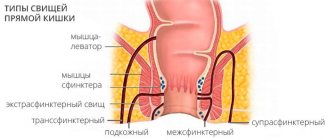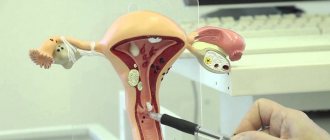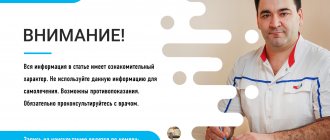Tetralogy of Fallot
Tetralogy of Fallot is one of those defects in which cyanosis can appear gradually. Sometimes it is barely noticeable, and only indicators of hemoglobin and red blood cells can indicate a constant undersaturation of arterial blood with oxygen (there is even the term “pale tetralogy”), but this does not change the anatomical essence of the defect itself.
By definition (“tetrad” means “four”) with this defect there are four violations of the normal structure of the heart.
- The first of the four components of a tetrad is a large ventricular septal defect. Unlike the defects mentioned above, with tetralogy it is not just a hole in the septum, but the absence of a section of the septum between the ventricles. It simply does not exist, and thus the communication between the ventricles is unimpeded.
- The second component is the position of the aortic mouth. It is shifted forward and to the right relative to the norm, and appears to be sitting “on top” of the defect. The word “on horseback” fits very accurately here. Imagine a man riding a horse - one leg to the right, the other to the left of the croup, and the torso in the center and above it. So the aorta turns out to be sitting in the saddle above the formed hole and above both ventricles, and does not extend only from the left, as in a normal heart. This is the so-called "dextroposition"
(i.e., displacement to the right) of the aorta, or its partial origin from the right ventricle, is the second of four components
of the tetralogy of Fallot . - The third component is a muscular, intraventricular, narrowing of the outflow tract of the right ventricle, which opens at the mouth of the pulmonary artery. The trunk and branches of this artery are also often much narrower than normal.
- And finally, fourth, a significant thickening of all the muscles of the right ventricle, its entire wall, several times greater than its normal thickness.
What happens in the heart, to which nature has given such a difficult task? How to provide oxygen to the body of a newborn baby? After all, you have to deal with this!
Let's see what happens to the blood flow in such a situation. Venous blood from the vena cava, i.e. from the whole body, passes into the right atrium. It enters the right ventricle through the tricuspid valve. And here there are two ways: one - through a wide-open defect into the aorta and into the systemic circulation, and the other - into the pulmonary artery narrowed at the beginning, where the resistance to blood flow is much greater.
It is clear that in a small circle, i.e. a smaller part of the venous blood will pass through the lungs, and most of it will go back to the aorta and mix with the arterial blood. This admixture of venous, unoxidized blood creates general undersaturation and causes cyanosis
. Its degree will depend on what part of the blood in the large circle is undersaturated, i.e. venous, and to what extent those “protection” mechanisms were activated - an increase in the number of red blood cells, which we talked about above. Thickening of the muscle wall of the right ventricle is only its response to a significantly increased load compared to the norm.
Immediately after birth, the child looks normal, but after a few days you can notice his anxiety, shortness of breath at the slightest exertion, the main of which is now sucking.
The cyanosis may be completely unnoticeable or may only be detected when crying. The child is gaining weight normally. However, sometimes he suddenly begins to choke, rolls his eyes, and it is not entirely clear whether he is conscious at such a moment or not. The condition lasts from a few seconds to several minutes, and goes away as suddenly as it began. This is a dyspnea-cyanotic attack
, dangerous even if it is short-lived, because its outcome is unpredictable. Of course, even at the slightest suspicion of such a condition, you should immediately see a doctor.
With tetralogy of Fallot, attacks, as part of the clinical picture, can occur even in the absence of pronounced cyanosis. In general, cyanosis with this defect is revealed, as a rule, in the second half of life, and sometimes later. There may also be no attacks - they are associated with the degree of narrowing of the outflow tract of the right ventricle, which, of course, is different for all patients.
Children with tetralogy of Fallot can live for several years, but their condition inevitably worsens: the cyanosis becomes very pronounced, children look exhausted, and are sharply behind their peers in development. The most comfortable position for them is squatting.
, with your knees tucked under you. They find it difficult to move, play, lead and enjoy a normal life. They are seriously ill. The diagnosis will be made at the first competent cardiological examination, after which the question of surgical care will immediately arise. The degree of urgency depends on the specific situation, but the operation cannot be delayed: the consequences of cyanosis and seizures can become irreversible if they lead to neurological disorders and, especially, damage to the central nervous system. In a situation where cyanosis is little or not expressed at all (the so-called “pale tetrad”), the danger is less, but it still exists.
What are the surgical treatment methods for tetralogy of Fallot?
There are two ways. The first is to close the ventricular septal defect and remove the obstruction to blood flow in the right ventricle and pulmonary artery. This is a radical correction of the defect.
It is clear that it is performed on an open heart under artificial circulation.
Today it can be done at any age, however, not always and not everywhere. There is always a risk with open heart surgery. But the variants of the anatomy of the tetralogy of Fallot , although they have one common name, differ from each other, sometimes significantly, and the risk is sometimes too great to perform such a large reconstructive operation “in one go.” Fortunately, there is another way - to first perform a palliative, auxiliary operation.
Anastomosis between the systemic and pulmonary circles
During this operation, an anastomosis is created - an artificial shunt, i.e. communication between the circulation, which actually represents a new arterial duct (instead of the one that closed naturally). When one of the vessels of the systemic circulation is connected to the pulmonary artery, the “blue”, “semi-venous” blood, undersaturated with oxygen, will pass through the lungs, and the amount of oxygen in it will increase significantly. This operation is closed, does not require artificial circulation, and is very well developed, even for the smallest children.
Today it is performed by sewing a short synthetic tube between the beginning of the subclavian artery and the pulmonary artery. The diameter of the tube is 3–5 mm, and the length is 2–3 cm.
This operation, which saved the lives of thousands of children, is used not only for tetralogy of Fallot , but also for other congenital defects with cyanosis, the cause of which is a narrowing of the outflow tract of the right ventricle and insufficient blood supply to the pulmonary bed, i.e. into the pulmonary circulation. In the future, regarding other defects, we will not dwell on the principle of this operation in such detail, but will say “anastomosis between the systemic and pulmonary circles,” implying that you already know what we are talking about.
The results of the operation are amazing: the child turns pink right on the operating table, as if he took a deep breath for the first time in his life. Signs of cyanosis disappear immediately, as do dyspnea-cyanotic attacks, and the child’s immediate life seems cloudless. But it only seems so. The main flaw remains. Moreover, we added another one to him, although we thereby helped him survive.
Patients who have had an anastomosis can live 5-10 years or more. But even if there are no complications, over time the function of the anastomosis deteriorates and becomes insufficient: after all, the child is growing, the defect is not corrected, and the size of the anastomosis is constant. And although the child feels well, the thought that he has not been completely cured will not leave you alone. We advise you to prepare yourself for subsequent correction of the defect within 6–12 months after the first operation.
Radical correction consists of closing the defect with a patch (after which the aorta will arise only from the left ventricle, as it should be), removing the narrowed area in the outflow tract of the right ventricle and dilating the pulmonary artery with a patch when necessary. If an anastomosis was previously performed, it is simply bandaged.
Which treatment method will be chosen depends on the specific situation - on the anatomy of the defect and on the condition of the child. Therefore, here we can limit ourselves to advice only.
The main thing is to try to calm down. You see, treatment is necessary and possible: there are reliable, time-tested methods of treatment. When should they be used? If a child is unwell, he is blue, he is developmentally delayed, he has seizures, which we wrote about above - there is simply no time for thinking. He needs to undergo palliative surgery, i.e. perform an anastomosis. And urgently to avoid possible complications. In addition, this operation will prepare the child and his heart for repeated, radical correction.
With a “pale” course of tetralogy of Fallot without attacks and without pronounced cyanosis and in the presence of conditions, it is possible to immediately make a radical correction without resorting to anastomosis. But it is advisable to perform such an operation in clinics where there is not only sufficient technical equipment, but also significant experience. There are more and more such clinics in our country.
The first serious attempts at surgical treatment of tetralogy of Fallot were made more than half a century ago, and it would not be an exaggeration to say that this is where all surgery for cyanotic congenital heart defects began. Over such a long period of time, treatment methods for tetralogy of Fallot have been developed in detail, and the results, even long-term (i.e. after 20-30 years), are excellent. And the accumulated experience shows that today this operation - in a one- or two-stage version - is quite safe and rewarding.
Patients who undergo treatment in early childhood become practically healthy, full-fledged members of society. They can study, work, and women can give birth and raise children, and many forget about the illness they suffered in childhood. As for the moral injuries associated with the entire process of surgical treatment, the child forgets about them, and it is very important that parents do not remind or instill in him that he was once very sick. This does not mean that there is no need to see doctors; after all, there was an operation, and it was complicated. Monitoring is necessary, since in the long term (after several years) heart rhythm disturbances or signs of pulmonary valve insufficiency may appear. These possible consequences of the defect (they can hardly even be called complications) are correctable, and the time is not far when the most common of them will be eliminated using closed X-ray surgical methods. The main condition for successful treatment of these phenomena is their timely recognition.
Let's summarize. Tetralogy of Fallot is a fairly common, severe, but completely curable heart defect. The sooner it is corrected surgically, the better results can be expected in the future. A child, and later a teenager and an adult, who was operated on in childhood for tetralogy of Fallot, should be periodically observed by specialists and lead a healthy lifestyle.
How to get treatment at the Scientific Center named after. A.N. Bakuleva?
Online consultations
What anomalies does the syndrome consist of, anatomical features
Tetralogy of Fallot includes a combination of four anomalies:
- defect in the interventricular septum;
- right-sided position of the aorta (as if “sitting astride” on both ventricles);
- stenosis or complete fusion of the pulmonary artery, it lengthens and narrows due to rotation of the aortic arch;
- pronounced right ventricular hypertrophy of the myocardium.
Among the combinations of defects with pulmonary artery stenosis and septal defects, there are 2 more forms, also described by Fallot.
The triad consists of:
- holes in the interatrial septum;
- pulmonary stenosis;
- right ventricular hypertrophy.
Pentad - adds to the first option the damaged integrity of the interatrial septum.
In most cases, the aorta receives a large volume of blood from the right side of the heart without sufficient oxygen concentration. Hypoxia is formed according to the circulatory type. Cyanosis is detected in a newborn child or in the first years of a baby’s life.
As a result, the infundibulum of the right ventricle narrows, and a cavity is formed above it, similar to an additional third ventricle. The increased load on the right ventricle contributes to its hypertrophy to the thickness of the left.
The only compensatory mechanism in this situation can be considered the appearance of a significant collateral (auxiliary) network of veins and arteries supplying blood to the lungs. The open botal duct temporarily maintains and improves hemodynamics.
Tetralogy of Fallot is typically associated with other developmental anomalies:
- non-closure of the ductus botallus;
- accessory superior vena cava;
- additional coronary arteries;
- Dandy Walker syndrome (hydrocephalus and underdevelopment of the cerebellum);
- in ¼ of patients the embryonic right aortic arch remains (Corvisart's disease);
- congenital dwarfism and mental retardation in children (Cornelia de Lange syndrome);
- defects of internal organs.
Diagnostics
The diagnosis is made by observing the child and the presence of objective signs. Information from relatives about development and activity, attacks with loss of consciousness and cyanosis are taken into account.
When examined in children, attention is drawn to the cyanotic nature of the lips and the altered shape of the terminal phalanges of the fingers. Rarely does a “heart hump” form.
On percussion, the borders of the heart are not changed or expanded in both directions. During auscultation, a rough systolic murmur is heard to the left of the sternum in the fourth intercostal space due to the passage of blood flow through the hole in the interventricular septum. It is better to listen to the patient in the supine position.
On the radiograph, the contours of the cardiac shadow resemble a “shoe” directed to the left
Due to the absence of the pulmonary artery arch, retraction occurs in the place where the vessels are usually located. A depleted lung appears more transparent. Enlargement of the heart to a large size does not occur.
A general blood test determines the adaptive response to hypoxia in the form of an increase in the number of red blood cells and an increase in hemoglobin.
Ultrasound diagnostics using a conventional ultrasound machine or Doppler ultrasound allows you to accurately determine changes in the chambers of the heart, abnormal development of blood vessels, the direction and magnitude of blood flow.
The ECG shows signs of right-sided cardiac hypertrophy, possible right bundle branch block, and the electrical axis is significantly deviated to the right.
Probing of the cavities of the heart with measurement of pressure in the chambers and vessels is carried out in specialized clinics when deciding on surgical treatment.
Less commonly, coronary angiography and magnetic resonance imaging may be required.
In differential diagnosis, it is necessary to exclude a number of diseases:
- transposition of the pulmonary artery causes a significant enlargement of the heart as the child grows;
- fusion at the level of the tricuspid valve promotes hypertrophy not of the right, but of the left ventricle;
- Eisenmenger's tetralogy - a defect accompanied not by fusion, but by dilation of the pulmonary artery; its pulsation and characteristic pattern of pulmonary fields are determined on an x-ray;
- stenosis of the pulmonary artery lumen is not accompanied by a “shoe” picture.
Doppler ultrasound helps to distinguish atypical forms.
Features of hemodynamics
The severity of the defect is determined by the degree of narrowing of the diameter of the pulmonary artery. To diagnose and determine treatment tactics, it is important to distinguish three types of anomalies:
- with complete fusion (atresia) of the arterial lumen: the most severe disorder, with a large interventricular foramen, the mixed blood of both ventricles is directed predominantly to the aorta, oxygen deficiency is pronounced, in the case of complete atresia, blood enters the lungs through the open ductus arteriosus or through collateral vessels;
- acyanotic form: with moderate stenosis, the obstacle to the blood flow from the right ventricle can be overcome by a lower pressure than in the aorta, then the blood discharge will take a favorable path from the artery to the vein, the defect variant is called “white”, since cyanosis of the skin does not form;
- cyanotic form with stenosis of varying degrees: caused by the progression of obstruction, discharge of blood from right to left; this causes a transition from the "white" form to the "blue" form.
Causes
The causes of the anomaly are considered to be effects on the fetus in the early stages of pregnancy (from the second to the eighth week):
- infectious diseases of the expectant mother (rubella, measles, influenza, scarlet fever);
- taking alcohol or drugs;
- treatment with hormonal drugs, sedatives and sleeping pills;
- toxic effect of nicotine;
- intoxication with industrial toxic substances in hazardous industries;
- a hereditary predisposition is possible.
The use of pesticides in the garden without respiratory protection affects not only the health of the woman, but also her offspring
The important thing is that at a short period of time a woman may not notice pregnancy and independently provoke fetal pathology.
Symptoms
The clinical picture appears:
- significant cyanosis - located around the lips, in the upper half of the body, intensifies when the child cries, feeds, strains;
- shortness of breath - has a paroxysmal nature associated with physical activity, the child takes the most comfortable “squatting” position, due to a temporary reflex additional spasm of the pulmonary artery and the cessation of blood oxygen saturation by 2 times;
- fingers in the shape of “drum sticks”;
- physical underdevelopment and weakness of children; running, outdoor games cause increased fatigue, dizziness;
- convulsions - associated with hypoxia of brain structures, blood thickening, and a tendency to thrombosis of cerebral vessels.
The form of the disease depends on the age of the child, and it determines the adequacy of compensation; in a newborn, cyanosis is visible on the face, hands and feet
There are:
- early manifestations in the form of cyanosis immediately after birth or in the first 12 months of life;
- The classic course is considered to be the manifestation of cyanosis at two to three years of age;
- severe form - paroxysmal clinical picture with shortness of breath and cyanosis;
- late - cyanosis appears only by 6 or 10 years;
- acyanotic form.
An attack of shortness of breath can occur at rest: the child becomes restless, cyanosis and shortness of breath intensify, the heart rate increases, loss of consciousness with convulsions and subsequent focal manifestations in the form of incomplete paralysis of the limbs is possible.










